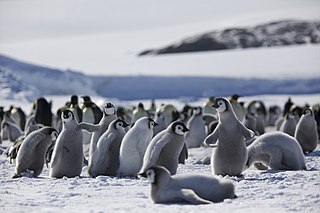
Behavioral ecology, also spelled behavioural ecology, is the study of the evolutionary basis for animal behavior due to ecological pressures. Behavioral ecology emerged from ethology after Niko Tinbergen outlined four questions to address when studying animal behaviors: What are the proximate causes, ontogeny, survival value, and phylogeny of a behavior?
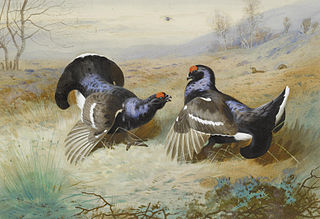
Group selection is a proposed mechanism of evolution in which natural selection acts at the level of the group, instead of at the level of the individual or gene.

A pack hunter or social predator is a predatory animal which hunts its prey by working together with other members of its species. Normally animals hunting in this way are closely related, and with the exceptions of chimpanzees where only males normally hunt, all individuals in a family group contribute to hunting. When hunting cooperation is across two or more species, the broader term cooperative hunting is commonly used.
Philopatry is the tendency of an organism to stay in or habitually return to a particular area. The causes of philopatry are numerous, but natal philopatry, where animals return to their birthplace to breed, may be the most common. The term derives from the Greek roots philo, "liking, loving" and patra, "fatherland", although in recent years the term has been applied to more than just the animal's birthplace. Recent usage refers to animals returning to the same area to breed despite not being born there, and migratory species that demonstrate site fidelity: reusing stopovers, staging points, and wintering grounds.

Stegodyphus lineatus is the only European species of the spider genus Stegodyphus. Male S. lineatus can grow up to 12 mm long while females can grow up to 15 mm. The colour can range from whitish to almost black. In most individuals the opisthosoma is whitish with two broad black longitudinal stripes. Males and females look similar, but the male is generally richer in contrast and has a bulbous forehead. The species name refers to the black lines on the back of these spiders. S. lineatus is found in the southern Mediterranean region of Europe and as far east as Tajikistan.

.

Eusociality, the highest level of organization of sociality, is defined by the following characteristics: cooperative brood care, overlapping generations within a colony of adults, and a division of labor into reproductive and non-reproductive groups. The division of labor creates specialized behavioral groups within an animal society which are sometimes referred to as 'castes'. Eusociality is distinguished from all other social systems because individuals of at least one caste usually lose the ability to perform at least one behavior characteristic of individuals in another caste. Eusocial colonies can be viewed as superorganisms.
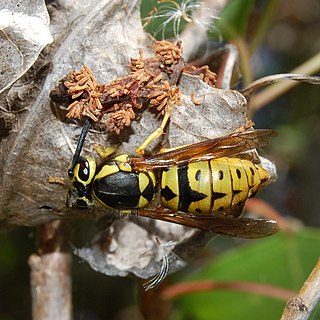
Vespula pensylvanica, the western yellowjacket, is a Nearctic species of wasp in the genus Vespula. It is native to regions of North America, largely in areas with northern temperate climates. Its reproductive behavior is constrained by cold weather, which successfully reduces the number of western yellowjackets in cold months. However, in the absence of cold weather, this wasp's population can explode. The western yellowjacket has become particularly invasive in the Hawaiian Islands, resulting in their label as a major pest.
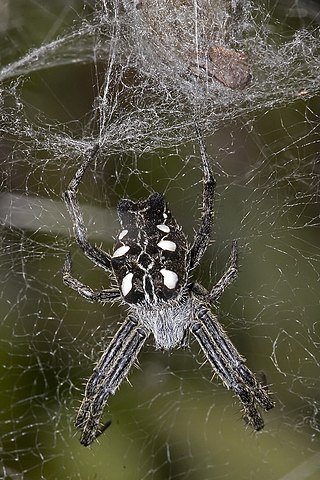
Cyrtophora citricola, also known as the tropical tent-web spider, is an orb-weaver spider in the family Araneidae. It is found in Asia, Africa, Australia, Costa Rica, Hispaniola, Colombia, and Southern Europe and in 2000, it was discovered in Florida. C. citricola differs from many of its close relatives due its ability to live in a wide variety of environments. In North America and South America, the spider has caused extensive damage to agricultural operations.

Anelosimus eximius is a species of social spider in the genus Anelosimus, native to the Lesser Antilles and the area from Panama to Argentina. Colonies can comprise several thousand individuals.

Eusociality evolved repeatedly in different orders of animals, notably termites and the Hymenoptera. This 'true sociality' in animals, in which sterile individuals work to further the reproductive success of others, is found in termites, ambrosia beetles, gall-dwelling aphids, thrips, marine sponge-dwelling shrimp, naked mole-rats, and many genera in the insect order Hymenoptera. The fact that eusociality has evolved so often in the Hymenoptera, but remains rare throughout the rest of the animal kingdom, has made its evolution a topic of debate among evolutionary biologists. Eusocial organisms at first appear to behave in stark contrast with simple interpretations of Darwinian evolution: passing on one's genes to the next generation, or fitness, is a central idea in evolutionary biology.
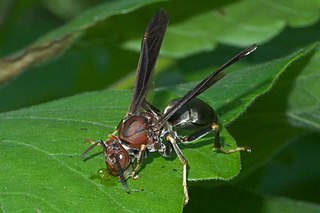
Polistes metricus is a wasp native to North America. In the United States, it ranges throughout the southern Midwest, the South, and as far northeast as New York, but has recently been spotted in southwest Ontario. A single female specimen has also been reported from Dryden, Maine. Polistes metricus is dark colored, with yellow tarsi and black tibia. Nests of Polistes metricus can be found attached to the sides of buildings, trees, and shrubbery.
Synalpheus regalis is a species of snapping shrimp that commonly live in sponges in the coral reefs along the tropical West Atlantic. They form a prominent component of the diverse marine cryptofauna of the region. For the span of their entire lives, they live in the internal canals of the host sponge, using it as a food resource and shelter. It has been shown that colonies contain over 300 individuals, but only one reproductive female. Also, larger colony members, most of which apparently never breed, defend the colony against heterospecific intruders. This evidence points towards the first known case of eusociality in a marine animal.

Polistes versicolor, also known as the variegated paper wasp or yellow paper wasp, is a subtropical social wasp within Polistes, the most common genus of paper wasp. It is the most widely distributed of South American wasp species and is particularly common in the Southeastern Brazilian states. This social wasp is commonly referred to as the yellow paper wasp due to the distinct yellow bands found on its thorax and abdomen. The P. versicolor nest, made of chewed vegetable fiber, is typically a single, uncovered comb attached to the substrate by a single petiole. The yellow wasp is frequently found in urban areas. New nests and colonies are usually founded by an association of females, sometimes in human buildings.
Inbreeding avoidance, or the inbreeding avoidance hypothesis, is a concept in evolutionary biology that refers to the prevention of the deleterious effects of inbreeding. Animals only rarely exhibit inbreeding avoidance. The inbreeding avoidance hypothesis posits that certain mechanisms develop within a species, or within a given population of a species, as a result of assortative mating and natural and sexual selection, in order to prevent breeding among related individuals. Although inbreeding may impose certain evolutionary costs, inbreeding avoidance, which limits the number of potential mates for a given individual, can inflict opportunity costs. Therefore, a balance exists between inbreeding and inbreeding avoidance. This balance determines whether inbreeding mechanisms develop and the specific nature of such mechanisms.
Leticia Avilés is an Ecuadoran evolutionary biologist and ecologist who studies the evolution of social behavior and the evolution of life history traits in metapopulations. Her methods include a combination of theory and empirical work, the latter using social spiders as a model system. Her research on these organisms has addressed questions such as why some spiders live in groups, why do they exhibit highly female-biased sex ratios, and why have they evolved a system where individuals remain in the natal nest to mate from generation to generation.

Lasioglossum hemichalceum, which has sometimes been confused with L. erythrurum, is a sweat bee endemic to Australia. Large numbers of unrelated females will typically share a single nest, a behavior referred to as "communal". Nests are constructed underground by the independent efforts of the females. L. hemichalceum will typically begin creating new colonies during the summer, with brood production from late November through the first few months of spring. Members of this species do not demonstrate aggressive behavior towards one another. As the size of the colony increases, the reproductive potential of each female does not change, unlike many species of bees.
Stegodyphus sarasinorum, also known as the Indian cooperative spider, is a species of velvet spider of the family Eresidae. It is native to India, Sri Lanka, Nepal, and Myanmar. This spider is a social spider that exhibits communal predation and feeding, where individuals live in large cooperatively built colonies with a nest or retreat constructed of silk woven using leaves, twigs, and food carcasses, and a sheet web for prey capture.

Stegodyphus dumicola, commonly known as the African social spider, is a species of spider of the family Eresidae, or the velvet spider family. It is native to Central and southern Africa. This spider is one of three Stegodyphus spiders that lives a social lifestyle. This spider has been studied living in large natal colonies in large, unkempt webs. Each colony is composed mainly of females, where a minority act as reproducers, and a majority remain childless and take care of the young. Males live a shorter lifespan, during which they will largely remain in the natal nest. Females are known for extreme allomaternal care, since all females – even unmated virgin ones – will take care of the young until they are eventually consumed by the brood.

Parawixia bistriata is a spider species found mainly in South America. It is known to have social foraging behavior. Due to its complex social system, it can live in habitats with various resource levels. Recently, its social behavior has been well-studied. Also, this species can collectively change its web structure in response to changes in prey type. They live collectively in web systems and thrive in both dry and wet climates. The size of its body is very small, typically 2 cm (0.8 in) long.
















